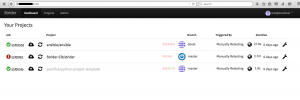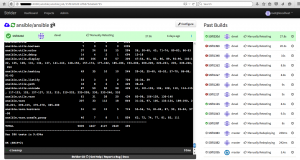After several check on the web looking for ansible strider role, I created my own here: StriderCD Ansible Role
$ mkdir strider_test $ cd strider_test $ mkdir roles $ ansible-galaxy --roles-path=./roles install cocoy.strider - downloading role 'strider', owned by cocoy - downloading role from https://github.com/cocoy/ansible-role-strider/archive/master.tar.gz - extracting cocoy.strider to ./roles/cocoy.strider - cocoy.strider was installed successfully - adding dependency: Stouts.mongodb - adding dependency: Stouts.nodejs - downloading role 'mongodb', owned by Stouts - downloading role from https://github.com/Stouts/Stouts.mongodb/archive/2.1.10.tar.gz - extracting Stouts.mongodb to ./roles/Stouts.mongodb - Stouts.mongodb was installed successfully - downloading role 'nodejs', owned by Stouts - downloading role from https://github.com/Stouts/Stouts.nodejs/archive/1.1.8.tar.gz - extracting Stouts.nodejs to ./roles/Stouts.nodejs - Stouts.nodejs was installed successfully $ cp roles/cocoy.strider/tests/* . $ ls Vagrantfile ansible.cfg roles test.yml
It’s now ready for vagrant up command.
Below are my screenshots, after using the same playbook on AWS instance.
References:
https://fosterelli.co/creating-a-private-ci-with-strider.html
https://linuxmeerkat.wordpress.com/2014/12/11/jenkins-time-is-over/
http://doics.co/2014/10/15/strider-ci-without-the-overhead/

